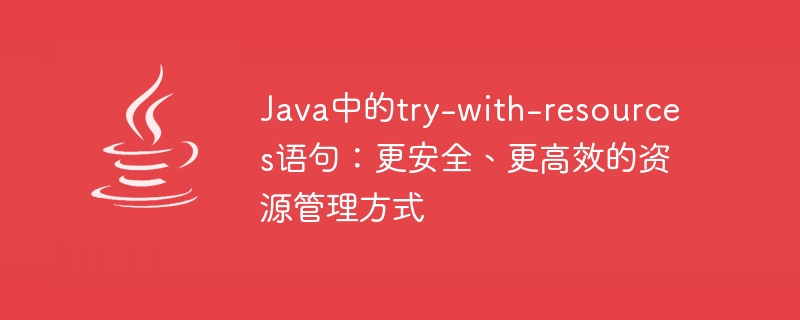

The try-with-resources statement in Java: a safer and more efficient way to manage resources
In Java programming, resource management has always been an important issue , especially when dealing with resources such as files, network connections, and database connections that need to be closed manually. In order to avoid resource leaks and simplify resource management, Java 7 introduced the try-with-resources statement. This syntax structure makes resource management safer and more efficient.
In this article, we will delve into the usage, principles and advantages of the try-with-resources statement compared with the traditional try-finally statement to help readers better understand and utilize this powerful feature.
1. Traditional resource management methods
Before Java 7, developers usually used the traditional try-finally statement to close resources when using resources, such as:
InputStream inputStream = null; try { inputStream = new FileInputStream("file.txt"); // 执行操作 } catch (IOException e) { // 异常处理 } finally { if (inputStream != null) { try { inputStream.close(); } catch (IOException e) { // 异常处理 } } }
The above code shows the traditional resource management method, opening the resource in the try block and closing the resource in the finally block. Although this approach ensures that the resource is closed, the code is verbose and requires processing multiple levels of nested try-catch blocks.
2. The use of try-with-resources statement
Java 7 introduces the try-with-resources statement, which improves the resource management method and makes the code more concise and safer. Using the try-with-resources statement, you can declare one or more resources within parentheses after the try keyword, and then use these resources in the try block without explicitly closing the resources. The example is as follows:
try (InputStream inputStream = new FileInputStream("file.txt")) { // 使用资源 } catch (IOException e) { // 异常处理 }
In this example, we use the try-with-resources statement to open the file and use the input stream of the file in the try block. When the try block ends, the input stream will be automatically closed. , no need to manually write code to close resources.
Using the try-with-resources statement can not only simplify the code, but also ensure the safe closing of resources. Even if an exception occurs when using resources, the resources will be automatically closed, avoiding the risk of resource leakage. This is something that the traditional try-finally statement cannot achieve.
3. AutoCloseable interface and automatic closing of resources
The implementation of the try-with-resources statement depends on the AutoCloseable interface. Only classes that implement this interface can be used in try-with-resources statements. The AutoCloseable interface defines a method named close, which is used to close resources, for example:
public interface AutoCloseable { void close() throws Exception; }
When a class implements the AutoCloseable interface and implements the close method in it, instances of the class can be used in a try-with-resources statement and automatically closed at the end of the try block.
4. Advantages of the try-with-resources statement
Compared with the traditional try-finally statement, the try-with-resources statement has the following advantages:
In actual development, especially where a large amount of resources are used (such as file operations, database connections, etc.), the try-with-resources statement can better improve the robustness and maintainability of the code. sex.
5. Application Example
Let’s give a specific application example to demonstrate the use of the try-with-resources statement:
try (FileInputStream input = new FileInputStream("input.txt"); FileOutputStream output = new FileOutputStream("output.txt")) { // 读取input.txt并写入output.txt int data; while ((data = input.read()) != -1) { output.write(data); } } catch (IOException e) { // 异常处理 }
In this example, we use The try-with-resources statement opens two files, input.txt and output.txt, at the same time, and performs file copy operations in the try block. At the end of the try block, the input and output streams of these two files will be automatically closed, without the need to manually write code to close the resources.
6. Summary
In this article, we have an in-depth discussion of the try-with-resources statement in Java, introducing its usage, principles, and advantages over the traditional try-finally statement. . By using the try-with-resources statement, resources can be managed more safely and efficiently, which can greatly improve the quality and maintainability of the code in actual development.
To sum up, the try-with-resources statement is an important feature introduced in Java 7, which provides a more convenient and secure way for resource management and is an indispensable part of modern Java programming. It is hoped that developers can take advantage of this feature and write more robust and efficient code.
The above is the detailed content of Improved resource management: using try-with-resources statements in Java is safer and more efficient. For more information, please follow other related articles on the PHP Chinese website!
